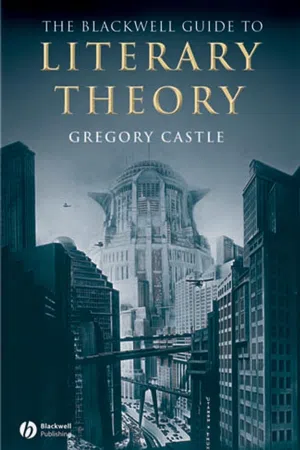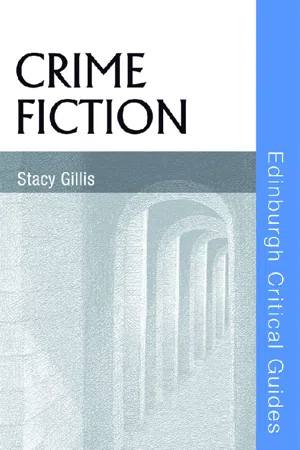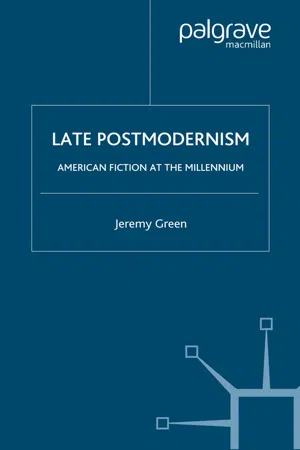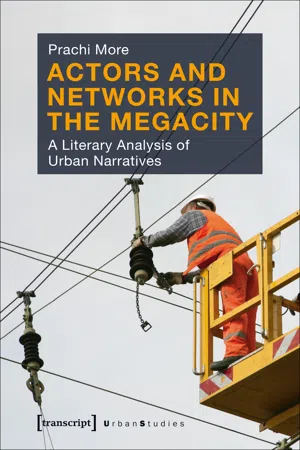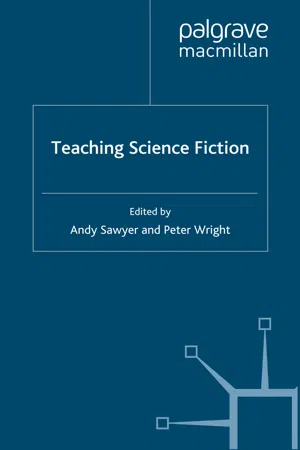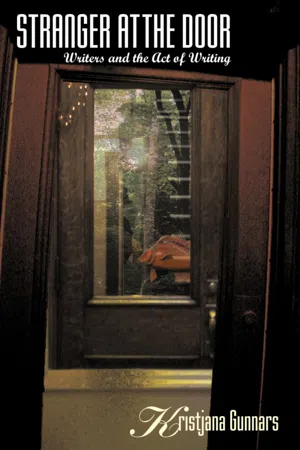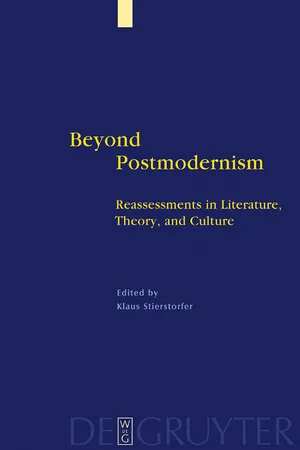Literature
Postmodern Literary Theory
Postmodern literary theory is a critical approach that emerged in the mid-20th century, challenging traditional literary conventions and emphasizing the role of language, power, and subjectivity in shaping meaning. It questions the idea of a single, objective truth and embraces fragmentation, intertextuality, and metafiction. Postmodern literary theory encourages readers to engage with texts in a more open and critical manner.
Written by Perlego with AI-assistance
Related key terms
1 of 5
10 Key excerpts on "Postmodern Literary Theory"
- Nick Bentley, Nick Hubble, Leigh Wilson, Nick Bentley, Nick Hubble, Leigh Wilson(Authors)
- 2015(Publication Date)
- Bloomsbury Academic(Publisher)
As mentioned earlier, some of these terms Introduction 17 problematize the idea of time itself, but the sheer range of them suggests something of the broad desire in literary and cultural criticism to move beyond the postmodern, while recognizing its continuing importance as a critical shadow cast over the first decade of the twenty-first century. As Potter and López note, in the new century, ‘it is impossible to avoid considering postmodernism’ (3). The desire to interrogate the legacies of postmodernism is mirrored in the work of several British novelists in the 2000s and can be identified in three strands: those novelists who continue to use narrative techniques associated with postmodernism but who have reintroduced a set of grounded ethical positions; those who have attempted to return (or continue) to work in a broadly realist mode as an implicit rejection of postmodernism; and those who have self-consciously returned to modernist techniques as a way of return to a pre- postmodernist aesthetics. These categories overlap and as often with the attempt to shoehorn writers and their work into a particular modal framework, much depends on the critical lens applied to aspects of their work. In the first category, however, it is possible to include writers such as Nicola Barker, A.L. Kennedy, Hari Kunzru, Toby Litt, Tom McCarthy, David Mitchell, Ali Smith and Will Self who have all continued to use the self-reflexive and metafictive complexities associated with postmodernism in their fiction, but have also tried to come out of the other side of the relativism this implies with an alternative sets of ethical positions appropriate to the new millennium. David Mitchell’s novels, for example, operate in textual worlds in which characters reappear and themes crisscross various geographical locations and historical settings.- eBook - PDF
- Gregory Castle(Author)
- 2009(Publication Date)
- Wiley-Blackwell(Publisher)
That is to say, Postmodernism seeks to discover entirely new ways of thinking about communication and expression, in many cases drawing on the resources of the internet and other electronic media. With respect to literary texts, Postmodernism shares with Poststruc-turalism a strong aversion to traditional notions of authors, texts, and 146 canons and an equally strong attraction to INTERTEXTUALITY and PLAY . In some respects, Postmodernism appears to depart significantly from what Fredric Jameson calls “aesthetic Modernism.” Hassan, in Dismem-berment of Orpheus (1971), defi ned Postmodernism as a rejection of the commitment to realism behind Modernist experimentation in favor of a literature of ludic self-reference, a METADISCOURSE that eschews old-fashioned plot lines and character development in favor of what Hutcheon calls “narcissistic narrative” and Robert Scholes FABULATION . Both concepts refer to a self-conscious attitude towards literary structure and writing that often serves as the central theme of the work itself. This is in part an effect of the rejection of realistic or MIMETIC representation, for if there is no intrinsic relation between language and the “real” world, then language becomes the only thing that literary works can effectively “re-present.” But this tells only part of the story, for, as Lyotard suggests, the Postmodern movement is caught up in the presentation of the un presentable, that which has been ignored, occluded, or repressed. M ETAFICTIONAL strategies, therefore, are more than simply narcissistic, or at least they should be, for presenting the un presentable is an act of liberation. For Hutcheon, metafiction aims to revolutionize literature as well as the society that produces it by forcing readers to look at language and texts in new ways: “the narcissistic novel as incitement to revolution-ary activity would be the ultimate defence of self-conscious fiction against claims of self-preening introversion” (155). - eBook - PDF
- Nick Bentley(Author)
- 2008(Publication Date)
- EUP(Publisher)
In keeping with its embrace of multiplicity it is more accurate to talk in terms of postmodernisms rather than a clearly de fi ned theoretical discourse. It is important to note therefore that the term postmod-ernism does not relate to a fi xed set of characteristics or criteria, but is a rather fl uid term that takes on di ff erent aspects when used by di ff erent critics and di ff erent social commentators. An area of critical thought that has been in fl uential to the devel-opment of postmodern techniques in fi ction is poststructuralism. This tends to argue that language, far from being a transparent tool that allows people to describe the world in an accurate way, is in fact more like a gauze or fi lter through which the world is textually reconstructed. This emphasis on the constructedness of language has challenged the assumption in much realist fi ction that the way in which an author used language was as an aid to expressing emo-tions faithfully or describing aspects of the real world accurately. Poststructuralism, on the contrary, argues that the attempt to record realistic experience through the medium of language is fraught with problems and that when someone attempts to write about some aspect of the world, they are not simply describing what is already there, but constructing it anew, and creating it in a textual form. narrative forms 33 Postmodernism, then, has two opposites: modernism and realism. The traditional understanding of formal realism is based on its ability to represent some aspect of the world accurately in a narrative form. Ian Watt, for example, describes formal realism with a series of characteristics including the use of identi fi able locations and periods of history, characters that are representative of people you might meet in real life, a plot structure based on cause and e ff ect, and an assumption that language is referential and denotational. - eBook - PDF
Late Postmodernism
American Fiction at the Millennium
- J. Green(Author)
- 2005(Publication Date)
- Palgrave Macmillan(Publisher)
Oddly, the development of the con- cept of postmodernism in literary and cultural theory has also tended to leave postmodern fiction by the wayside. Fiction was central to early North American attempts to elaborate and define postmodernism. But with the explosion of theories of postmodernism, the influx of post- structuralism, and the pioneering work of Lyotard and Jameson, novels took up a comparatively marginal place, and studies of postmodern fiction ceased to be essential to the debate, assuming an ancillary function to one side of philosophical ruminations on the legacy of the enlightenment and failings of metaphysics. Early definitions of postmodernism arose in the context of the literary activity of the 1960s and 1970s. Critical work published in Boundary 2: A Journal of Postmodern Literature (from 1972 onward) addressed the poetics of the Black Mountain school and San Francisco renaissance, as well as fiction by writers then grouped under a number of competing headings, including metafiction, surfiction, and parafiction. This critical attention coincided with and was nourished by currents of thought from the con- tinent, particularly Heideggerian phenomenology and structuralism. At the same time, critical work by Ihab Hassan, Gerald Graff, Philip Stevick, and Jerome Klinkowitz established the case for a movement in literary fiction that represented at least a modulation of modernist impulses into something distinct and identifiable, a body of work that formed the first sketch for a canon of postmodern literature. 17 The excitement and interest generated by this work was accompanied by an unusually close relationship between fiction and critical writing on the part of several of the major practitioners. William Gass, Ishmael Reed, Raymond Federman, Ronald Sukenick, Susan Sontag, and John Barth all wrote criticism in addition to fiction, and established in their work fruitful conversations between the two. - eBook - PDF
Actors and Networks in the Megacity
A Literary Analysis of Urban Narratives
- Prachi More(Author)
- 2017(Publication Date)
- transcript Verlag(Publisher)
13 In the postmodern strain of experimentation, there was also a linkage of generally contradictory spheres of reality such as technology and myth or realism with fantasy. Even as postmodern works sustained the emphasis on the mediated status of all representation, their aim was nevertheless to aspire to represent and comment on the social world. On the other hand, the unease with regard to representation manifested itself also as an inability to represent something, as in the trauma narratives of Holocaust-survivors or post-9/11 stories. Their often debilitating experience is conveyed through an ‘absence’ or ‘lack’, which can be narratively represented only through devices such as the blurring of ontology (boundary blurring) or destabilization of meaning. 14 Rather than constitute a crisis, such paradigms readily suggest radical plurality as the fundamental condition of postmodernist writing. This can be seen from the many mixed genres such as metafiction, historiographic metafiction, and varieties of the non-fiction novel that came to be celebrated. 15 An implicit anxiety about the 12 | This refers largely to structuralist critique of literary realism. See for example Barthes, “To Write: An Intransitive Verb?,” who equates realism with the “totalitarian ideology of the referent.” (159). 13 | Hence the engagement with terms such as blurred genre or hybrid genre. See respectively, Geertz, “Blurred Genres”; Nünning, “Mapping the Field of Hybrid New Genres in the Contemporary Novel”; On the other hand, one could speak of a dialogue with realism in genres such as magical realism or metafiction. See also Hutcheon, Narcissistic Narrative , who quite rightly criticizes literary theory’s tendency to view new literary trends as simply redefinitions of the real (36–7). 14 | See Onega Jaén, Contemporary Trauma Narratives ; and Gibbs, Contemporary American Trauma Narratives . 15 | In the American context, we also have the development of New Journalism and the nonfiction novel. - eBook - PDF
- A. Sawyer, P. Wright, A. Sawyer, P. Wright(Authors)
- 2011(Publication Date)
- Palgrave Macmillan(Publisher)
Postmodernism, Postmodernity and the Postmodern 131 Fredric Jameson. Thomas Docherty’s anthology, Postmodernism: A Reader (1992), is a very useful gathering together of many theoretical strands, if rather male-dominated in his choice of author. Absent from this selection are Donna Haraway and the French feminists, especially Julia Kristeva and Hélène Cixous. In literary studies there is an understandable attempt to break the discipline down into digestible chunks; these are frequently defined by period – medieval, Elizabethan, Jacobean, eighteenth-century, Romantic, Victorian, modernist and then nebulous categories such as ‘contemporary’ or ‘postwar’. Modernism is a name given to a range of artistic movements between roughly 1900 and 1930, characterized by an aesthetic of newness and refreshment in form and content – it covered poetry (figures such as T.S. Eliot, Ezra Pound and the Imagists), novels (Virginia Woolf, James Joyce), painting (Wyndham Lewis, Pablo Picasso), music (Igor Stravinsky, Arnold Schoenberg), architecture (Le Corbusier, Mies van der Rohe) and beyond. There was a sense that the world was facing an abyss – a worldview confirmed by the First World War – after a century in which humanity was revealed to be related to an ape (Charles Darwin’s theory of evolution) and identity was sup- posed to be largely unconscious (Sigmund Freud). The new art broke from straightforward representations of a shared notion of reality to a more complex depiction of a fractured and disturbed world. The objects produced might not look like art at all – see Marcel Duchamp’s ready- made ‘Fountain’ (1917), a urinal signed R. Mutt, intended to be shown at the Society of Independent Artists’ exhibition in New York. The science fiction of the period is not interested in technology or the space-time continuum, nor in new forms in the same way as mod- ernist texts are. - eBook - PDF
Stranger at the Door
Writers and the Act of Writing
- Kristjana Gunnars(Author)
- 2006(Publication Date)
- Wilfrid Laurier University Press(Publisher)
The choice the-ory-fiction makes is to opt for multiplicity and multivalency at the expense of ease and comfort. Postmodernism looks for a kind of dialogic in the face of the monologue imposed on us. It is dialogical writing that takes into account the other voices in the community and interacts with them, even at the time of writing. After all, the whole idea of cul-ture in the West is rendered suspect by its history. To quote André Brink, from his essay “The Languages of Culture,” Western “culture was the prerogative of the aristocracy, to be emulated later, in the wake of the French Revolution, by the bourgeoisie” (226). Given this fact, Brink continues, “how can it [culture] be regarded—at least by the Third World—other than with suspicion, doubt, or open rejection?” (226). It is no longer possible to assume our cultural codes are intact, and can STRANGER AT THE DOOR 64 or should be transmitted in a package. Introducing theoretical metafic-tion into imaginative literature is one way of disassembling the context which is suspect anyway, and remaking it. There is an extra impetus for the inclusion of theory in fiction for the woman writer. There is a certain pressure imposed on women writ-ers, that their work be “moving,” emotional, and therefore that it should exclude the intellect. It is harder, in other words, to be accepted if what you do is intellectual, because that is not expected of you if you are a woman. However, engaging the intellect along with the poetic is a healthy thing to do. Why would you not want to engage the whole mind, all parts of it, rather than just your emotions? It would be like hav-ing a large vocabulary at your disposal but using only a few words of it. It is unnecessary to see a discrepancy, or even a division, between what we know as academic and what we think of as creative writing. There is no good reason to compartmentalize like that. - eBook - PDF
New Directions in Social Theory
Race, Gender and the Canon
- Kate Reed(Author)
- 2006(Publication Date)
- SAGE Publications Ltd(Publisher)
This chapter is largely concerned with the impact of postmodernism on social theory. It focuses on the way in which the social theoretical canon has been opened up to include those previously excluded, focusing in particular (as throughout the book) on issues of gender and race. I start by looking at the effects of postmodernism on sociological theory. Postmodernism and Sociological Theory What is postmodernism? According to Delamont (2003), at its simplest, post-modernism is a challenge to the consensus among the educated classes in the western capitalist nations, since the Enlightenment at the end of the eighteenth century, that universal, objective scientific truths can be reached by scientific methods. Doubts about the modernist project have encouraged many authors to challenge the triumph of progress and the validity of scien-tific knowledge. Postmodern theorists argue instead that we have entered a new age, the postmodern condition, which has generated a much more rela-tivistic view of the world (Marsh 2000). The rational and the rigid guidelines of the grand theories and meta-narratives of modernism have been swept away and replaced by the irrational and flexible elements of a far more relativist position in which ‘anything goes’. Those social theorists working within a postmodern framework have op-posed traditional sociological theory as it existed in the past. According to Mouzelis (1994), postmodernism and post-structuralism oppose conven-tional social theory on three fronts: they are against foundationalism and uni-versalism; they are against the notion of the centred subject, favouring social practices instead; they are also against the notion of representation and empirical reference, in particular questioning the very existence of a social reality out there for sociologists to study. - eBook - PDF
Beyond Postmodernism
Reassessment in Literature, Theory, and Culture
- Klaus Stierstorfer(Author)
- 2012(Publication Date)
- De Gruyter(Publisher)
3 There is no need to deny that postmodernism reconsiders and re-enacts all literary conventions and this one - the humanistic subject - in the first place. I would like to change the focus of the analysis and to investigate what happens to art when it shifts its centre, as I believe postmodernism does, from the deep level of character, typical of psychological realism and modernism, to the level beyond individual personality, which I define as a level of mentality - a complex integrity of mental and spiritual orientations of literary character, of author and of reader. Not the selfless, decentered, fragmented character of a literary hero, but the situation of Man and Humanity is the subject of this art today. In postmodernist art at the turn of the second Millennium a new emphasis is laid on the writer's authorial self-consciousness, on the notions of originality, uniqueness, universality. It is felt in John Barth's criticism of the death of the author theory, which was advocated by Roland Barthes, whose books still have a great resonance. What the French Poststructuralist believes to be only a paper-I, 4 is full of meaning for the American writer and does not exclude the presence of the author as the subject of art. Barth, both a theoretician and a practitioner of postmodernism, in the essay with the polemical title The Self in Fiction, or, 'That Ain't No Matter. That Is Nothing' argues against this death verdict, this 'fall from innocence' on the part of literature which Roland Barthes seems to date from about 3 p.m. - eBook - PDF
- Maggie McKinley(Author)
- 2021(Publication Date)
- Cambridge University Press(Publisher)
To get at this difference, it is useful to introduce two terms that add nuance to the categories of “realism” and “postmodernism” I have been using so far: “technomodernism” and “high cultural pluralism.” These terms come from The Program Era (), Mark McGurl’s influential account of the dynamic relationship between universities and post- literary production. McGurl’s analysis of “the culture of the school” elaborates the forms of “institutionality” at work in the literary field in the second half of the twentieth century, a period when many writers studied or taught at newly-established creative writing programs or were employed within university English departments. Barth – who taught in universities for forty years – is one of McGurl’s prime examples of a writer whose work emerges from this web of institutionality, not least in Giles Goat-Boy (), a “disciplinary allegory” in which a university represents the universe. More broadly, Barth is also a case study in “technomodern- ism.” This adjustment of the term “postmodernism” is meant to empha- size, first, the crucial interest in information technology that distinguishes the systems novels of DeLillo, Gaddis, and Pynchon (and which definitely isn’t among Roth’s major themes), and second, the high esteem afforded to the idea of techne, or craft, within the academic contexts in which much of this kind of fiction was written and read. In contrast to technomodernism, McGurl outlines another strand of post–World War II fiction: high cultural pluralism, composed mainly of ethnic minority and women writers. Chiming with the liberal cultural pluralism of the postwar era, fiction in this camp championed the work of writers from demographics usually occluded from the canon; thus began the tendency to imagine the literary field as sub-divided into Jewish- American, African-American, and Asian-American fiction, and so on.
Index pages curate the most relevant extracts from our library of academic textbooks. They’ve been created using an in-house natural language model (NLM), each adding context and meaning to key research topics.

